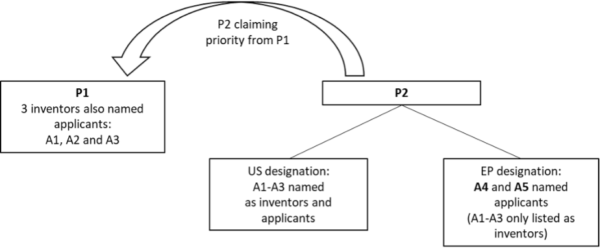New referrals to the Enlarged Board of Appeal of the EPO – Who is entitled to priority?
Recently, a Board of Appeal (BoA) referred questions to the Enlarged Board of Appeal (EBoA) relating to entitlement of priority in PCT applications. The referrals are pending under numbers G 1/22 and G 2/22.
Why is this referral important? Because a granted patent can be found invalid based on an incorrect naming of applicants on a patent application. Thus, it matters who is named applicant and who is not.
For example: You are the inventor of a first patent application and you as an individual are also named as the only applicant on that patent application. Within 12 months from the filing date of the first patent application, you can file a subsequent patent application claiming priority* from the first patent application.
During the time since the first application was filed, you may have started a company, which shall own your patent applications from now on, or you may have teamed up with a new partner (company or individual) who shall own the subsequent application or co-own it with you.
Now, i.e., before filing of the subsequent application, is the time to carefully choose who is going to be named applicant of the subsequent patent application – and don’t worry, we at BRANN AB can guide you through this process!
The EPO’s current practice is that when filing a European patent application claiming priority, applicants (or their successors in title) may be added but not deleted relative to the application from which priority is claimed.
Thus, in the example above, the applicant of the first application can either
(1) be named applicant also in a subsequent European patent application claiming priority from the first application, together with their new partner named as co-applicant (a.k.a. joint applicant), or
(2) assign their rights to the invention of the first application, and their rights to claim priority, to the new company/partner before filing of the subsequent European patent application, in which case the applicant of the first application shall not be named applicant of the subsequent European patent application. Instead, only their new partner shall then be named applicant of the subsequent European patent application.
This EPO practice applies also if there are several co-inventors who are all listed as applicants of the first patent application, and who then team up with one or more new partners who shall own or co-own a subsequent application claiming priority from the first application.
The questions recently referred to the EBoA focus on whether the EPO’s current “joint applicants approach” is applicable to PCT applications, particularly in cases where the named applicants for a PCT application are different for different designated PCT states.
The cases cited in the referrals both stemmed from the PCT application WO2005110481 (P2), claiming priority from a US provisional application (P1). Inventors and applicants of the two applications were as follows:

At the filing date of P2, the right to claim priority from P1 had only been assigned from A3 to A4, not from A1 or A2 to A4.
A5 later assigned their rights to A4, who in the subsequent opposition procedure at the EPO basically argued that applicants A1 and A2 should be considered joint applicants with A4 for the European (EP) designation of the PCT application, given that A1 and A2 were named applicants on the US designation of the PCT application. However, the EPO’s Opposition Division agreed with the opponent that the priority claim for the EP designation of P2 was invalid because A4 was not the successor in title of the applicant A1 or A2 of the priority application P1.
The Board of Appeal (BoA) handling the subsequent appeal cases noted divergent BoA practice as to whether the priority claim of the EP designation of a PCT application is valid in cases like those outlined above. The BoA concluded that the issue was a point of law of fundamental importance which deserved being referred to the EBoA.
The questions referred to the EBoA:
- Does the EPC confer jurisdiction on the EPO to determine whether a party validly claims to be a successor in title as referred to in Article 87(1)(b) EPC?
- If question I is answered in the affirmative: Can a party B validly rely on the priority right claimed in a PCT-application for the purpose of claiming priority rights under Article 87(1) EPC in the case where:
- a PCT-application designates party A as applicant for the US only and party B as applicant for other designated States including regional European patent protection and
- the PCT-application claims priority from an earlier patent application that designates party A as the applicant and
- the priority claimed in the PCT-application is in compliance with Article 4 of the Paris Convention?
Answers from the EBoA can be expected within a few years. In the meantime, if you have questions about claiming priority or other IP related issues, please contact your BRANN attorney!
